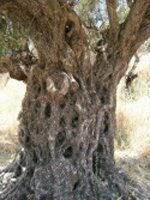| Judaism and the environment |

|

|
|
The Jewish tradiotn is not one that need to ‘go green’. We are perhaps the forerunners of the ‘go green’ movement. Environmentalism has been deeply planted in our roots.
Honi and the Carob Tree: One day Honi was journeying on the road and he saw a man planting a carob tree. Honi asked him, “How long does it take to bear fruit?” The man replied, “Seventy years.” Honi further asked him, “Are you certain that you will live another seventy years?” The man replied, “I found this world provided with carob trees and as my forebears planted these for me, so I too plant them for my children. Honi then sat down to have a meal, and sleep overcame him. As he slept, a small cave formed around him, which hid him from sight. He continued to sleep for seventy years. When he awoke, he saw a man gathering the fruit of the carob tree and Honi asked him, “Are you the man who planted this tree?” The man replied, “I am his grandson.” Babylonian Talmud- Ta’anit 23a
This excerpt from the Babylonian Talmud is a reminder of our responsibility as Jews to take care of the environment for the sake of generations to come. Should we get caught up with the details of our busy daily lives and need a reminder of this responsibility, we have one built into our calendar, the holiday of Tu Bishvat. Tu Bishvat is considered to be a minor holiday. It falls on the 15th day of the Hebrew month of Shevat. It is also known by many as the Jewish New Year of the Trees or Jewish Arbour Day. While the festival, at its basic level, reiterates the deep link between the Jewish people and the Land of Israel, understanding of its importance can be broadened to include our connection with not just the Land of Israel but with the earth in general. Tu Bishvat is not mentioned in the Torah but its significance and the themes it represents fill our daily readings. We actually first hear mention of the “New Year of the Trees” in the Mishnah. Scholars believe that its roots were as an agricultural festival that coincided with the beginning of the first signs of spring in ancient Palestine. The Diaspora, following the Destruction of the Second Temple, transformed this holiday into a spiritual event and a reaffirmation of the bond that Jews have with the Land of Israel. In modern days, following the establishment of the State of Israel, the holiday again evolved to one with relevance for Jews living in the Diaspora as well as those in Israel. It is clear we have a rich tradition of showing respect for nature and animals and more than that, an affirmative responsibility to take measures to protect the environment. Tu Bishvat for many Jews is marked by the eating of nuts and fruits from the Land of Israel, planting trees in Israel or donating funds to the Jewish National Fund so that they may plant trees in Israel for us. In many communities a Tu Bishvat Seder is also held. On Shabbat, take the time to consider the environmental implications of the laws of Shabbat. Many secular, ecologically minded communities limit members’ rights to drive on certain days, encouraging alternative modes of transportation and rideshare. On Shabbat we refrain from use of electricity, gasoline, factory production and automobiles. What if we were all to refrain from the use of our cars, electricity and power for one day a week? In the collective, what effect would this have on the environment over time? This year, perhaps we can take the time to also use this opportunity to create a new tradtion. No matter how seemingly small and insignificant it may seem, try to implement just one additional ‘green’ practice into our own lives. It is an activity that even the youngest participant can engage in and draw out meaning from. With recent warnings on an international level on the threat the greenhouse effect and global warming will have on the environment, the time to act is now. Tu Bishvat is merely our reminder of our year round responsibility not only as Jews but as humans to care for the earth as it has cared for us.
(Issue December 2007 / January 2008)
|


















